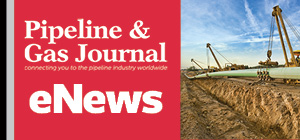Continued Midstream Infrastructure Development Expected After Market Rebound
The INGAA Foundation released its report North American Midstream Infrastructure – A Near Term Update Through 2025, which shows the oil and gas markets should rebound and lead to further midstream infrastructure development.

This report, developed for the Foundation by ICF, a global consulting and digital services provider, examines how the COVID-19 pandemic has affected oil and gas markets and midstream infrastructure, and how those impacts will ease over the next five years.
As the effects of the pandemic subside, ICF’s analysis indicates that markets will rebound as demand returns. Domestic natural gas use is expected to rise to an average of roughly 87.5 billion cubic feet per day in 2025 (about 3.6 percent above the 2019 level). Exports are expected to increase again as well, especially through pipelines to Mexico and LNG terminals serving world markets, prompting further infrastructure development.
“The pandemic has no doubt slowed the pace of infrastructure development as demand for natural gas and oil were impacted globally, but this report shows that will change as markets rebound,” said Tony Straquadine Jr., executive director of the INGAA Foundation. “The industry is well-positioned to respond to the needs and challenges outlined in this report as domestic demand and export capacity return to the trajectory we saw entering 2020.”
Key findings of the report include:
- Potential for infrastructure development is still significant, despite recent events, with significant additional natural gas capacity expected to be placed into service through major pipeline projects announced for 2020 through 2025.
- Gas infrastructure development continues to support the transition away from coal for power
- Gas Infrastructure will continue to support power system reliability as renewable power generation expands
- Natural gas is still a highly desired and cost-effective source of energy for space heating, water heating, cooking, and industrial
- Significant increases in exports of oil, gas (LNG and pipeline exports to Mexico), and NGLs will provide strong support for oil and gas
- Infrastructure development is swinging to the Permian and Haynesville areas with associated gas development continuing to lead the way for domestic gas
- Pipeline safety investments will continue to be an important focus for the foreseeable future following the recent adoption of extensive new PHMSA regulations and the PIPES Act of 2020
While permitting new infrastructure remains challenging, new demand-driven capacity is economically justified, even considering the strong headwinds created by COVID-19, the report concludes. The full copy of this report can be downloaded from the INGAA Foundation’s website: https://www.ingaa.org/Foundation.aspx.
Related News
Related News

- Kinder Morgan Proposes 290-Mile Gas Pipeline Expansion Spanning Three States
- Valero Plans to Shut California Refinery, Takes $1.1 Billion Hit
- Three Killed, Two Injured in Accident at LNG Construction Site in Texas
- Tallgrass to Build New Permian-to-Rockies Pipeline, Targets 2028 Startup with 2.4 Bcf Capacity
- TC Energy Approves $900 Million Northwoods Pipeline Expansion for U.S. Midwest
- U.S. Pipeline Expansion to Add 99 Bcf/d, Mostly for LNG Export, Report Finds
- Enbridge Adds Turboexpanders at Pipeline Sites to Power Data Centers in Canada, Pennsylvania
- Great Basin Gas Expansion Draws Strong Shipper Demand in Northern Nevada
- Cheniere Seeks FERC Approval to Expand Sabine Pass LNG Facility
- Heath Consultants Exits Locate Business to Expand Methane Leak Detection Portfolio




Comments